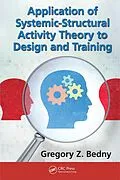Every complex human-machine system includes a computer as a critically important means of work. However, an operator's interaction with a computerized system cannot be reduced to only performing computer-based tasks. Today human-computer interaction (HCI) is not limited to trained software users. People of all ages use all different kinds of gadget
Autorentext
Gregory Bedny - He works as a Research Associate at Evolute, Inc. in Louisville, Kentucky. He has been conducting research on general and systemic-structural activity theory for the past 25 years. Systemic-structural activity theory is high level generality theory from which derived unified and standardize methods of study human work. He is the author of multiple articles in this field. He applied his theoretical study in field of human-computer interaction, manufacturing, merchant marines, robots systems, work motivation, training, reducing fatigue etc.
Waldemar Karwowski, Ph.D., D.Sc., P.E. is Professor and Chairman of the Department of Industrial Engineering and Management Systems at the University of Central Florida, USA. He is a Co-Editor of the Human Factors and Ergonomics in Manufacturing journal, and Editor-in-Chief of Theoretical Issues in Ergonomics Science journal. He is an author or editor of over 400 scientific publications in the areas of human systems integration, cognitive engineering, activity theory, systems engineering, human-computer interaction, fuzzy logic and neuro-fuzzy modeling, applications of nonlinear dynamics to human performance, and neuroergonomics.
Dr. I. S. Bedny is a computer professional with Ph.D. in Experimental Psychology. She is doing research applying SSAT to Human Computer interaction. She is the author or co-author of over 10 scientific publications in the field of HCI.
Zusammenfassung
Risk Assessment and Security for Pipelines, Tunnels, and Underground Rail and Transit Operations details a quantitative risk assessment methodology for systematically analyzing various alternatives for protecting underground rail, oil and gas pipelines, pipeline freight transportation, and other tunnel systems from terrorism threats and other disas
Inhalt
Activity Theory in Work Psychology and Ergonomics. General Characteristics of Activity Approach. Vector "Motive Goal" as a Basic Concept of Activity Theory. Vector "Motive Goal" and Brain Function. Concept of Task in Psychology and Ergonomics from Activity Theory Perspective. Basic Concepts and Terminology of Activity Theory. Informational and Energetic Components of Mental Activity. Cognitive Processes as Stages of Receiving, Transformation and Transmitting Information. Energetic-Informational Components Of Mental Activity. Self-Regulation and Human Performance. Analysis of Existing Concepts of Self-Regulation beyond Activity Theory. Concept of Self-Regulation in Activity Theory and Its Psycho-Physiological Analysis. Self-Regulation of Motor and Sensory-Motor Components of Activity. Self-Regulation of Cognitive Processes. General Principles of Self-Regulation of Activity and Strategies of Performance. Study Learning and Training as Self-Regulation Process. Qualitative and Formalized Stages of Activity Analysis and Design. Introduction to Ergonomic Design. Time Studies and Design. Work Pace and Ergonomic Design. Morphological Analysis of Work Activity. Quantitative Assessment of Human Performance and Work Design. Quantitative Assessment of Task at the Work Mechanization and Automaticity Stages. Quantitative Methods of Computer Based Tasks Assessment.
